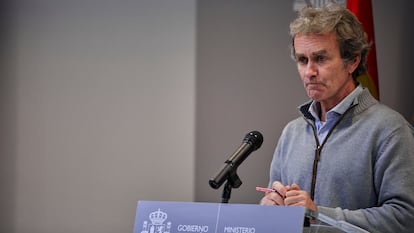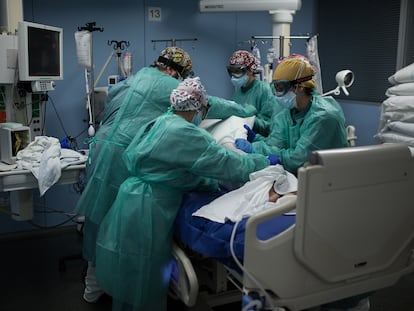Spain reports 35,878 new coronavirus infections and 201 deaths, as third wave progresses
Pressure on country’s hospitals continues to rise, with 19,000 patients currently being treated. The government is ruling out another home lockdown for now

The epidemiological curve of the coronavirus pandemic in Spain is steadily rising, and is now at levels registered during the peak of the second wave, which was seen last autumn. The 14-day cumulative number of coronavirus cases per 100,000 inhabitants is now well above 500, double the level considered to be high risk by the central government. On Thursday, the central Health Ministry reported 201 Covid deaths and 35,878 new infections, the second highest since the health crisis began. The record was set the previous day with 38,865. The pressure on hospitals is also rising, with non-essential surgeries being canceled in some regions in order to cope with the number of coronavirus patients. There are currently 19,000 people being treated in Spain’s hospitals with Covid, 2,849 of them in intensive care units (ICUs).
A total of 10 of Spain’s 17 regions now have a 14-day cumulative number of coronavirus cases per 100,000 inhabitants above 500. Extremadura is in the worst position, with an incidence of 1,167. The Balearic Islands, Castilla-La Mancha, Castilla y León, Valencia and Madrid are above 600, while Murcia and La Rioja both are at levels exceeding 700.
“The models developed indicate that there has been a significant change in trend between January 7 and 9,” said Fernando Simón, the director of the Health Ministry’s Coordination Center for Health Alerts (CCAES), during a press conference to present the latest report on Thursday. “And they are associated with a very short period of transmission, of a week, around the end of the year,” he added, in reference to the Christmas holiday season.

The government’s chief epidemiologist ruled out the new, more contagious strain of the coronavirus that was first identified in the United Kingdom as having an effect, and insisted that increased social interaction during Christmas is largely due to this rapid rise of the curve.
“It’s not that there has been greater transmissibility, but more people passing it on. We all know why,” he said. “Whether we want to be or not, we are all aware that at Christmas people were having a better time than they should have done. We could have proposed anything, but we knew that this was going to happen,” he stated.
Simón is taking for granted that the epidemiological curve will continue to rise for several more days, but he is hoping that the more restrictive measures that have been put in place after the Christmas holidays will put the brakes on the rhythm of infections. Hospitals, he said, will continue to be under stress for some time yet. “Our ICUs are suffering from an accumulation of cases in a short time, and this could continue to increase,” he said. The number of people in hospital with Covid has risen 76% since Christmas, a situation that has prompted a reorganization of activity in order to attend to the growing number of patients.
It’s not that there has been greater transmissibility, but more people passing it on. We all know whyFernando Simón, director of CCAES
Despite the rise in infections and the pressure on hospitals across the country, Simón ruled out another domestic lockdown, such as the one put in place last spring. This measure has been requested by the premiers of the Castilla y León, Asturias, Murcia and Andalusia regions, but the CCAES director believes that such a drastic move will not be necessary. “The second wave, which had a level of transmission during its peak similar to that being seen now, was controlled by measures that did not include complete confinement. The option of confinement is there, but with the level of transmission that we have and the specific characteristics of this third wave it doesn’t seem necessary now,” he argued.
Simón did warn that the number of deaths from the virus will continue to rise. After incidence rises, then hospitalizations increase, followed by ICU admissions, fatalities are the last data point to go up. According to the official data from the Health Ministry, since the start of the pandemic more than 53,000 people have died after a positive Covid-19 tests. Simón made clear last night, however, that the ongoing vaccination campaign will have an impact on the fatality rate in the short term, given that the most vulnerable groups in society will have been given the inoculations before long and the risk of infection and death will start to fall.
English version by Simon Hunter.
Tu suscripción se está usando en otro dispositivo
¿Quieres añadir otro usuario a tu suscripción?
Si continúas leyendo en este dispositivo, no se podrá leer en el otro.
FlechaTu suscripción se está usando en otro dispositivo y solo puedes acceder a EL PAÍS desde un dispositivo a la vez.
Si quieres compartir tu cuenta, cambia tu suscripción a la modalidad Premium, así podrás añadir otro usuario. Cada uno accederá con su propia cuenta de email, lo que os permitirá personalizar vuestra experiencia en EL PAÍS.
¿Tienes una suscripción de empresa? Accede aquí para contratar más cuentas.
En el caso de no saber quién está usando tu cuenta, te recomendamos cambiar tu contraseña aquí.
Si decides continuar compartiendo tu cuenta, este mensaje se mostrará en tu dispositivo y en el de la otra persona que está usando tu cuenta de forma indefinida, afectando a tu experiencia de lectura. Puedes consultar aquí los términos y condiciones de la suscripción digital.
More information
Últimas noticias
Most viewed
- Reinhard Genzel, Nobel laureate in physics: ‘One-minute videos will never give you the truth’
- Pablo Escobar’s hippos: A serious environmental problem, 40 years on
- Charles Dubouloz, mountaineering star, retires at 36 with a farewell tour inspired by Walter Bonatti
- Why we lost the habit of sleeping in two segments and how that changed our sense of time
- The fall of a prolific science journal exposes the billion-dollar profits of scientific publishing











































